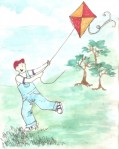2
Mar
Posted by Stacie in homeschool ideas, Kindergarten, Phonics and Reading, Preschool, science, teaching phonics, teaching reading. Tagged: help children, homeschool, kids, kindergarten, lesson plans, water, weather, wind. Leave a comment
Weather Review

Objective: To review weather.
Preparation:
- Find pictures or drawings of weather in books, magazines, internet, or old calendars.
- Have crayons, pencils or markers to finish the books.
- Print the template for the weather book. Cut into 2 pages. Use half a sheet of construction paper for the cover.
- weather book template page 1 weather book template page 2
- Suggested Book: Weather by Gallimard Jeunesse
Lesson:
Read the book and discuss:
- Discuss any pictures of weather.
- Discuss what weather the children have seen.
- Review ideas from other weather lessons.
Activity:
Help the kids make their weather book by reading and discussing each page as they work. When finished, read the book together.
Suggested Discussion questions:
- What do you wear when it’s snowy; rainy; etc. ?
- What kinds of activities can you do when it’s snowy; rainy; etc.?





Check out our website: http://www.phonicsbyspelling.com/
1
Mar
Posted by Stacie in Phonics and Reading, science, teaching phonics. Tagged: air, homeschool ideas, lesson plans, Pinwheel, Pinwheel Pattern, Pinwheel template, preschool lessons, weather, wind. Leave a comment

Wind
Objective: To learn about and experience wind and air.
Preparation:
- Find drawings, books, magazines or old calendars of wind.
- Have crayons, pencils or markers for the children.
- Square paper or print out pin wheel template. pinwheel template
- New pencil, straw or make your own stick by rolling up paper.
- Straight pins.
- Masking tape.
Books:
- Wind by Ron Bacon
- Wind by Marion Dane Bauer
Lesson:
- Explain to the children that wind is moving air.
- Wind is invisible.
- Discuss some of the signs that tell us it is windy. (Use pictures or books) Give them clues such as clouds moving in the sky, wind chimes ringing, feeling the winds on our skin, and leaves or paper blowing across the yard.
- People use wind for many different things such as; flying a kite, sailing a sailboat, or blowing windmills to create electricity.
Activity: Pinwheel pinwheel template
- Give the children the square or template.
- Have the children color and decorate both sides of the pinwheel.
- Have them cut on the diagonal lines. Making sure to have them stop cutting where the line stops.
- Take every other point and bring it to the center of the pinwheel.
- Push a pin through four of the points and the center of the pinwheel. Then push the pin through the eraser of the pencil or about ½ inch from the top of a straw or rolled paper.
- Bend the end of the pin down against the pencil, straw or rolled paper. Leave a little space between the pin and stick so the pinwheel spins freely.
- Wrap several times with masking tape to keep in place and to cover the sharp end of the pin.
Optional activities:
Kite: http://www.ehow.com/how_4742941_make-paperbag-kite.html
Check out our website: http://www.phonicsbyspelling.com/
1
Mar
Posted by Stacie in homeschool ideas, Kindergarten, Preschool, science. Tagged: air, homeschool ideas, oxygen, preschool lessons, teaching, weather, wind. Leave a comment
 Air/Weather
Air/Weather
Objective: Help children understand how air affects the world around us.
Preparation:
- Find drawings or pictures books, magazines or old calendars of wind, plants, and animals.
- Have a large balloon.
- Have crayons, pencils or markers for drawing.
- Drawing paper.
- Decide on a book to read. Suggested books:
- Air Is All Around You by Franklyn M. Branley
- If We Could See Air by David T. Suzuki
Lesson:
Read a book then discuss:
- Did you know that air is all around you?
- Without air there wouldn’t be any life on Earth? (Have everyone breathe in and exhale out.)
- Air is the gas that floats all around you and makes up our atmosphere. We can’t see it, since it is made up of colorless gases.
- Some of the gases that make up the air around us are oxygen, and carbon dioxide. We like to shorten carbon dioxide and just call it “CO2”.
- All life on Earth depends on air to stay alive. When we breathe, we inhale air. Our bodies use the oxygen.
- Humans and animals make CO2 and exhale it into the air.
- Plants use CO2 and put oxygen back into the air.
- Plants clean the air. Let’s give the plants some CO2. (Breathe in and exhale out again.)
- Although we usually can’t feel it, air is always touching us. (Blow up a balloon.)
- One of the few times that you can actually feel air is when it is windy. (Make wind by letting the air go in the balloon.)
- Air is used for many different things, such as flying planes, sailing on a sail boat, or blows windmills to create electricity.
Activity: Make an air cycle picture. 
- Give each child a sheet of drawing paper.
- Have the child draw a picture of self on one side of the paper and a tree on the other side.
- Draw an arrow from the tree to the child. and write “oxygen” by this arrow.
- Draw an arrow going from the child to the tree and write “ CO2” by that arrow.
- Have them lightly color some air with the side of a blue or gray crayon.
Optional activities are to make airplanes or kites.
Check out our website: http://www.phonicsbyspelling.com/








